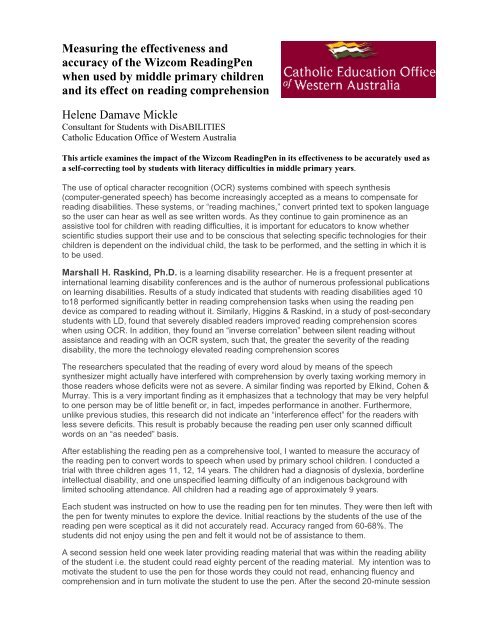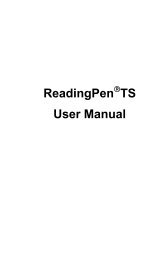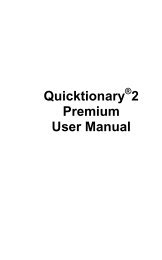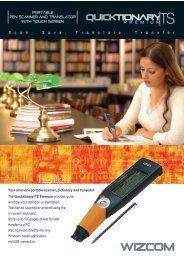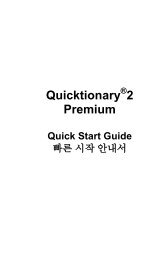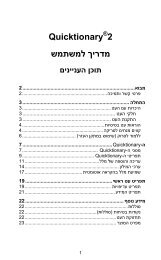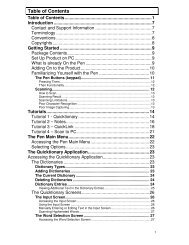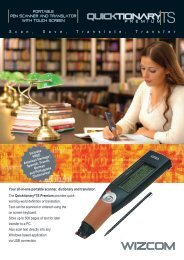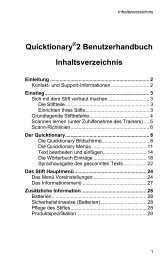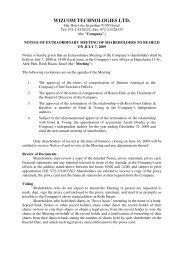Report on use of Reading Pen - Helene Mickle - 19 August 2008..pdf
Report on use of Reading Pen - Helene Mickle - 19 August 2008..pdf
Report on use of Reading Pen - Helene Mickle - 19 August 2008..pdf
You also want an ePaper? Increase the reach of your titles
YUMPU automatically turns print PDFs into web optimized ePapers that Google loves.
Measuring the effectiveness andaccuracy <strong>of</strong> the Wizcom <strong>Reading</strong><strong>Pen</strong>when <strong>use</strong>d by middle primary childrenand its effect <strong>on</strong> reading comprehensi<strong>on</strong><strong>Helene</strong> Damave <strong>Mickle</strong>C<strong>on</strong>sultant for Students with DisABILITIESCatholic Educati<strong>on</strong> Office <strong>of</strong> Western AustraliaThis article examines the impact <strong>of</strong> the Wizcom <strong>Reading</strong><strong>Pen</strong> in its effectiveness to be accurately <strong>use</strong>d asa self-correcting tool by students with literacy difficulties in middle primary years.The <strong>use</strong> <strong>of</strong> optical character recogniti<strong>on</strong> (OCR) systems combined with speech synthesis(computer-generated speech) has become increasingly accepted as a means to compensate forreading disabilities. These systems, or “reading machines,” c<strong>on</strong>vert printed text to spoken languageso the <strong>use</strong>r can hear as well as see written words. As they c<strong>on</strong>tinue to gain prominence as anassistive tool for children with reading difficulties, it is important for educators to know whetherscientific studies support their <strong>use</strong> and to be c<strong>on</strong>scious that selecting specific technologies for theirchildren is dependent <strong>on</strong> the individual child, the task to be performed, and the setting in which it isto be <strong>use</strong>d.Marshall H. Raskind, Ph.D. is a learning disability researcher. He is a frequent presenter atinternati<strong>on</strong>al learning disability c<strong>on</strong>ferences and is the author <strong>of</strong> numerous pr<strong>of</strong>essi<strong>on</strong>al publicati<strong>on</strong>s<strong>on</strong> learning disabilities. Results <strong>of</strong> a study indicated that students with reading disabilities aged 10to18 performed significantly better in reading comprehensi<strong>on</strong> tasks when using the reading pendevice as compared to reading without it. Similarly, Higgins & Raskind, in a study <strong>of</strong> post-sec<strong>on</strong>darystudents with LD, found that severely disabled readers improved reading comprehensi<strong>on</strong> scoreswhen using OCR. In additi<strong>on</strong>, they found an “inverse correlati<strong>on</strong>” between silent reading withoutassistance and reading with an OCR system, such that, the greater the severity <strong>of</strong> the readingdisability, the more the technology elevated reading comprehensi<strong>on</strong> scoresThe researchers speculated that the reading <strong>of</strong> every word aloud by means <strong>of</strong> the speechsynthesizer might actually have interfered with comprehensi<strong>on</strong> by overly taxing working memory inthose readers whose deficits were not as severe. A similar finding was reported by Elkind, Cohen &Murray. This is a very important finding as it emphasizes that a technology that may be very helpfulto <strong>on</strong>e pers<strong>on</strong> may be <strong>of</strong> little benefit or, in fact, impedes performance in another. Furthermore,unlike previous studies, this research did not indicate an “interference effect” for the readers withless severe deficits. This result is probably beca<strong>use</strong> the reading pen <strong>use</strong>r <strong>on</strong>ly scanned difficultwords <strong>on</strong> an “as needed” basis.After establishing the reading pen as a comprehensive tool, I wanted to measure the accuracy <strong>of</strong>the reading pen to c<strong>on</strong>vert words to speech when <strong>use</strong>d by primary school children. I c<strong>on</strong>ducted atrial with three children ages 11, 12, 14 years. The children had a diagnosis <strong>of</strong> dyslexia, borderlineintellectual disability, and <strong>on</strong>e unspecified learning difficulty <strong>of</strong> an indigenous background withlimited schooling attendance. All children had a reading age <strong>of</strong> approximately 9 years.Each student was instructed <strong>on</strong> how to <strong>use</strong> the reading pen for ten minutes. They were then left withthe pen for twenty minutes to explore the device. Initial reacti<strong>on</strong>s by the students <strong>of</strong> the <strong>use</strong> <strong>of</strong> thereading pen were sceptical as it did not accurately read. Accuracy ranged from 60-68%. Thestudents did not enjoy using the pen and felt it would not be <strong>of</strong> assistance to them.A sec<strong>on</strong>d sessi<strong>on</strong> held <strong>on</strong>e week later providing reading material that was within the reading ability<strong>of</strong> the student i.e. the student could read eighty percent <strong>of</strong> the reading material. My intenti<strong>on</strong> was tomotivate the student to <strong>use</strong> the pen for those words they could not read, enhancing fluency andcomprehensi<strong>on</strong> and in turn motivate the student to <strong>use</strong> the pen. After the sec<strong>on</strong>d 20-minute sessi<strong>on</strong>
the student’s skill in using the pen had improved with reading pen accuracy increasing 70-80percent. Comprehensi<strong>on</strong> <strong>of</strong> the text increased to 98 percent.The third sessi<strong>on</strong> produced very similar resp<strong>on</strong>ses from the three students. All students were verykeen to <strong>use</strong> the pen and began exploring various opti<strong>on</strong>s that the reading pen encompasses. Allthree students’ reading accuracy using the pen increased to 90-92 percent with students being ableto <strong>use</strong> the menu to look at a range <strong>of</strong> opti<strong>on</strong>s that the reading pen <strong>of</strong>fers. Students gainedincreasing c<strong>on</strong>fidence to <strong>use</strong> the pen <strong>on</strong> a different range <strong>of</strong> texts including those that were bey<strong>on</strong>dthe reading age <strong>of</strong> the student.In summary, my findings c<strong>on</strong>cluded that students require short training sessi<strong>on</strong>s <strong>of</strong> 20 minutesmaximum to gain c<strong>on</strong>fidence in using the pen with texts that are c<strong>on</strong>sistent to their reading ageinitially. The reading pen accuracy <strong>of</strong> <strong>use</strong> increased within three 20 minute training sessi<strong>on</strong>s overthree weeks. <strong>Reading</strong> comprehensi<strong>on</strong> and c<strong>on</strong>fidence improved <strong>on</strong>ce 90 percent accuracy could beachieved by the <strong>use</strong>r. All but <strong>on</strong>e student felt they would <strong>use</strong> it <strong>on</strong> a regular basis, with the excepti<strong>on</strong><strong>of</strong> <strong>on</strong>e who felt that the device would highlight and stigmatise his reading disability (13-year-oldstudent) in fr<strong>on</strong>t <strong>of</strong> his peers. I believe this could be overcome by encouraging all students to <strong>use</strong>the pen and promote an acceptance <strong>of</strong> diversity within the classroom. In c<strong>on</strong>clusi<strong>on</strong> I found thereading pen a valuable assistive tool to promote reading comprehensi<strong>on</strong>, independence andc<strong>on</strong>fidence.__________________________________________________


